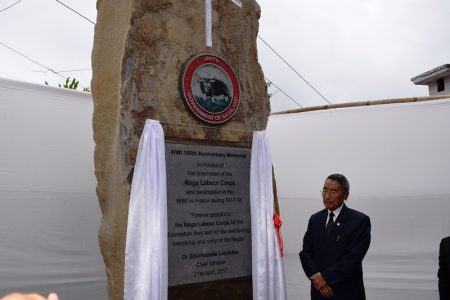
Speech of the Chief Minister Nagaland Dr Shurhozelie Liezietsu at unveiling of the the 1st World War Naga Labour Corps Memorial Monolith in Kohima on 21st April 2017.
It gives me immense honour and pride to unveil the Monolith dedicated to the 100th Anniversary of the Naga Labour Corps’ participation in the 1st World War. In particular, today the 21st of April marks the exact date when the first batch of the Naga Labour Corps set sail in 1917 for the 1st Great War theatre in Europe. One can hardly imagine the feelings that the Naga Labour Corps must have felt, leaving their homeland for the first time and crossing oceans to distant lands fighting for the then Crown. Certainly it was not India’s war and it was definitely not the Nagas’ War but the Naga Labour Corps participation and the bravery they exhibited during their battles in Europe and elsewhere would have ramifications much beyond the intended.
Around 2000 Nagas seem to have been recruited and this group of men were designated as the Naga Labour Corps. According to some written documents quoted in various books the Naga Labour Corps arrived in France in two main groups (688 men on 21 June 1917 and 992 men on 2 July 1917).The Naga Labour Corps were formed in the Naga Hills under the command of Deputy Commissioner, Herbert Charles Barnes.
These men were initially divided into the 15th , 16th, 17th and 18th Naga Labour Companies. To avoid confusion with other Indian Labour Corps units serving in Mesopotamia at that time, these companies were renumbered as the 35th, 36th, 37th and 38th (Naga) Labour Companies. The men of the Naga Labour Corps worked in various places around France on salvage work, road repairs among others. Legend has it that the Nagas fearlessly carried out their designated duties despite facing the horrors of war in the battlefield and were in the forefront mindless of the possibility of death all around them.
In particular, the 35th Coy left the Naga Hills as part of the Labour Corps on the 21st April 1917 and sailed for France on the 26th April. Subsequently after the war, the 35th Coy moved to Marseille in April 1918 from where they embarked for India at the end of May arriving back in India in June 1918. Unfortunately during the Second World War in 1940, the building holding the lists of men of the Naga Labour Corps units was destroyed by Japanese bombings. The relative lack of historical records should however not deter us from commemorating their pioneering ventures which led to the subsequent state of Nagaland.
There is no known Memorial in Nagaland to commemorate the Nagas who fought and the many who died in France. But amongst all the tribes who were sent to WW1 duties, the Nagas were the first to realize the need to organize and unite themselves. Men who returned from France formed a socio-political association called the Naga Club with branches in Kohima and Mokokchung immediately after their return in 1918. This was the association that later in 1929 submitted a representation to the Simon Commission and conveyed to them the right of choice of self-determination of the Nagas when the British left India. In fact, as mentioned, the state of Nagaland, has its direct bearings to the Naga Labour Corps which went to France during WW1 and even for this purpose alone, their brave mission must be remembered appropriately for posterity.
The Government of Nagaland has therefore decided to build a Memorial in honour of the Naga Labour Corps in Kohima. A Memorial Park will in due course be built around this hilltop to appropriately mark the 100th Anniversary. In the first instance, a Monolith is being unveiled today and a detailed blueprint of the Memorial is being worked out.
I have therefore chosen to pen a few words which will try to at least acknowledge their role in our modern history forever, which you see engraved in the Monolith and I repeat:
“Forever grateful to the Naga Labour Corps for the foundation they laid for the everlasting friendship and unity of the Nagas”.
The Naga Labour Corps created history for our present and for our better future. Let us never forget them for generations to come.